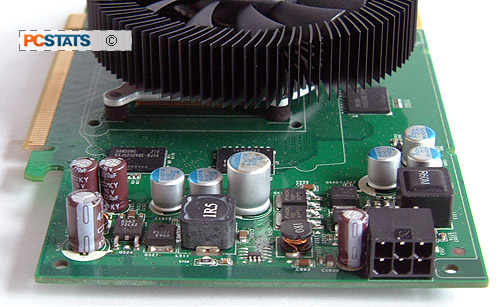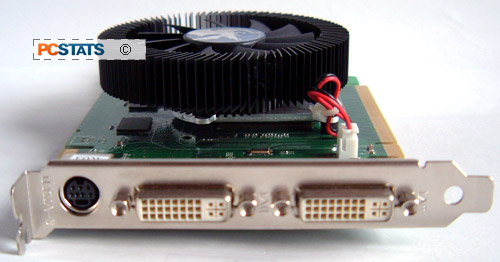The nVidia GeForce 8600GTS (aka 'G84' core) is built on
TSMC's 80nm manufacturing process and contains 289 million transistors. According to nVIDIA the
GeForce 8600GTS core has a maximum power draw of 71W, a hair below the 75W the PCI Express
x16 bus can provide. To be on the safe side the GeForce 8600GTS has a six
pin PCI Express power connector so if the videocard needs more power during overclocking
it gets it.
 By default the
nVidia GeForce 8600GTS has a default core speed of 675 MHz while the stream
processors hum along at 1.45 GHz. The nVidia G84 core only comes equipped with
32 stream processors as opposed to 96/128 with the nVidia G80 core.
By default the
nVidia GeForce 8600GTS has a default core speed of 675 MHz while the stream
processors hum along at 1.45 GHz. The nVidia G84 core only comes equipped with
32 stream processors as opposed to 96/128 with the nVidia G80 core.
The memory runs at a flat
2 GHz, yet with the GeForce 8600GTS the memory bus width is only 128
bits. That alone should tell potential users that the card will be
mainly memory bandwidth limited, especially so at higher resolutions or with AA
enabled. Maximum memory size is 256MB for all G84 based videocards.
Gone are the hard coded Vertex and
pixel shaders in the G84 core, they have been replaced with a more flexible
Stream Processor (or unified shader) that calculates both types of data. The
Stream Processors run at a blistering 1.45 GHz. Traditional core clock speeds as
we know it are dead, as several internal processors are running at different
speeds.
It's important to note that the GeForce
8600GT only has 32 stream processors while the sightly better GeForce 8800GTS
model has 96 and the 8800GTX 128. If you remember, 16 stream processors equals
one thread processor so there is only two in the nVidia G84 core.
Each Thread Processor has two groups of eight
Stream Processors, and each group talks to an exclusive texture address filter unit as
well as well as being connected to the shared L1 cache. When more memory is
needed, the Thread Processor connects to the crossbar memory controller.
nVIDIA's crossbar memory controller is broken up into two 64 bit chunks for a
total bus width of 128 bits.

By moving the GPU towards a threaded
design, the nvidia G84 is much more like a processor than any graphics core of
the past. Any type of data - be it pixel, vertex, or geometry shader can be
processed within the Stream Processor. This allows load balancing to occur
between the various tasks.
Examining CPU Load with PureVideo
To test
PureVideo's High Definition accelerating capabilities on the Biostar Sigma-Gate
GeForce 8600GTS, PCSTATS will play back a video downloaded from Microsoft's WMV HD Content Showcase through Windows Media
Player 10. "The Discoverers" (IMAX) video is available in both 720P and 1080P
formats. AMD processor utilization will be monitored via Task Manager.

When running the 720P version of the high definition Discoverers
video, CPU usage jumps between 15-18%. Not too bad and it leaves plenty of
resources for background tasks.

The 1080P version of the Discoverers video
uses even less CPU resources and CPU usage hovers between 13-15%. Next up are
the overclocking tests you've been eagerly
awaiting!
